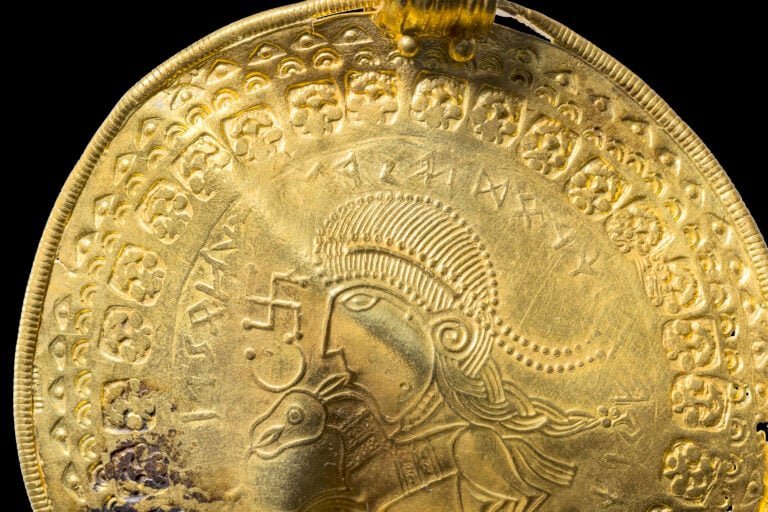A new find from Denmark, dubbed the Vindelev bracteate, has actually challenged previous understanding of faith in late prehistoric and early medieval Scandinavia.
This short article was composed by Marianne Hem Eriksen, Partner Teacher of Archaeology, University of Leicester. It was first released by our buddies at The Discussion.

.” class=”wp-image-74095″ data-sizes =”( max-width: 768px )100vw, 768px” srcset=” https://everythingviking.com/wp-content/uploads/2023/03/norse-mythology-is-norse-god-odin-older-than-previously-thought.jpg 768w , https://everythingviking.com/wp-content/uploads/2023/03/norse-mythology-is-norse-god-odin-older-than-previously-thought-3.jpg 300w, https://everythingviking.com/wp-content/uploads/2023/03/norse-mythology-is-norse-god-odin-older-than-previously-thought-4.jpg 1536w, https://www.lifeinnorway.net/wp-content/uploads/2023/03/file-20230317-3542-jhh7bj-2-2048×1366.jpg 2048w” > < img decoding=" async" width=" 754 "height=
” 416″ src =” https://everythingviking.com/wp-content/uploads/2023/03/norse-mythology-is-norse-god-odin-older-than-previously-thought-2.jpg” alt= “Odin with his ravens Huginn and Muninn” class =” wp-image-22536″ srcset=” https://everythingviking.com/wp-content/uploads/2023/03/norse-mythology-is-norse-god-odin-older-than-previously-thought-2.jpg 754w, https://www.lifeinnorway.net/wp-content/uploads/2018/06/odins-ravens-300×166.jpg 300w” sizes= “( max-width: 754px) 100vw, 754px” > Odin with his ravens Huginn and Muninn. Picture: Wikimedia Commons. Odin had the capability to form shift into animal form and might send his ideas and intent into the world in the kind of 2 ravens called Munin and Hugin. As 12-13th century Icelandic author Snorri Sturluson explains: Odin might change his shape: his body would lie as if dead, or asleep; but then he would remain in shape of a fish, or worm, or bird, or monster, and be off in a sparkling to remote lands.
Odin was a master of seiðr. Seiðr was a wonderful, ritual practice involving chanting, seeing and drumming into the future or speaking with the dead. According to Snorri, Odin found out seiðr from the goddess Freyja. Nevertheless, since seiðr was associated
with females and since its thrilled elements may have had sexual allusions, it was viewed as unmanly. This has led some scholars to question whether Odin was a queer god, or gender
fluid. What does the Vindelev bracteate tell us? In spite of the appeal of the Norse gods today, much about their history stays uncertain. The historic sources explaining these gods were written centuries after the truth by Christian authors. How reliably they describe Viking age beliefs has actually been debated. The find adds to several objects that confirm that the written sources are not purely the innovations of Christian authors in high middle ages Scandinavia. Whether the Odin of the Vindelev bracteate is quite the exact same character as the Odin of the middle ages sources practically 1,000 years later on is tough to ascertain. But the name had deep roots amongst the Scandinavians. The brand-new discovery also places the divine being among the Germanic peoples who added to the fall of the western Roman Empire. As a scholar researching the human body in the Iron and Viking ages in northern Europe, I am captivated
by the figure’s hair, which may be linked to compromised braids found in bogs in Scandinavia from centuries previously. This offers hints about hairdos and body ideals at the time and supports proof that
hair was a specifically important and meaningful part of the body. While the mention of Odin is exceptional, the glance of Jagaz( whoever he was) is likewise fascinating.
We can hypothesize that he lived in the early 400s in what is now Denmark, decorated his hair with a braid, thought in Odin and had a horse companion. He might have practised something similar to seiðr. Perhaps  he journeyed to the Roman Empire and acted as a soldier, returning with experiences of exotic animals, huge monoliths, foreign languages and gods
he journeyed to the Roman Empire and acted as a soldier, returning with experiences of exotic animals, huge monoliths, foreign languages and gods
that his neighborhood would have problem comprehending. Maybe he utilized his pay to have an exaggerated bracteate made, that he would eventually compromise in a gold stockpile in the ground. Despite gaps in the story, the Vindelev
bracteate opens new possibilities to imagine the extremely foreign worlds of past individuals– and their gods. This article was written by Marianne Hem Eriksen, Partner Teacher of Archaeology, University of Leicester. It was very first released by our pals at The Conversation.